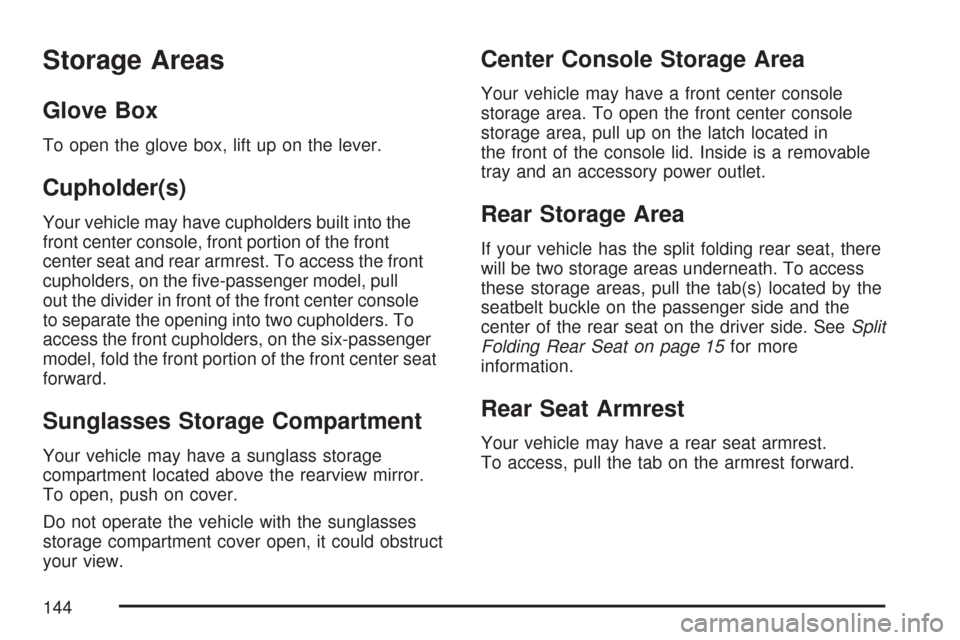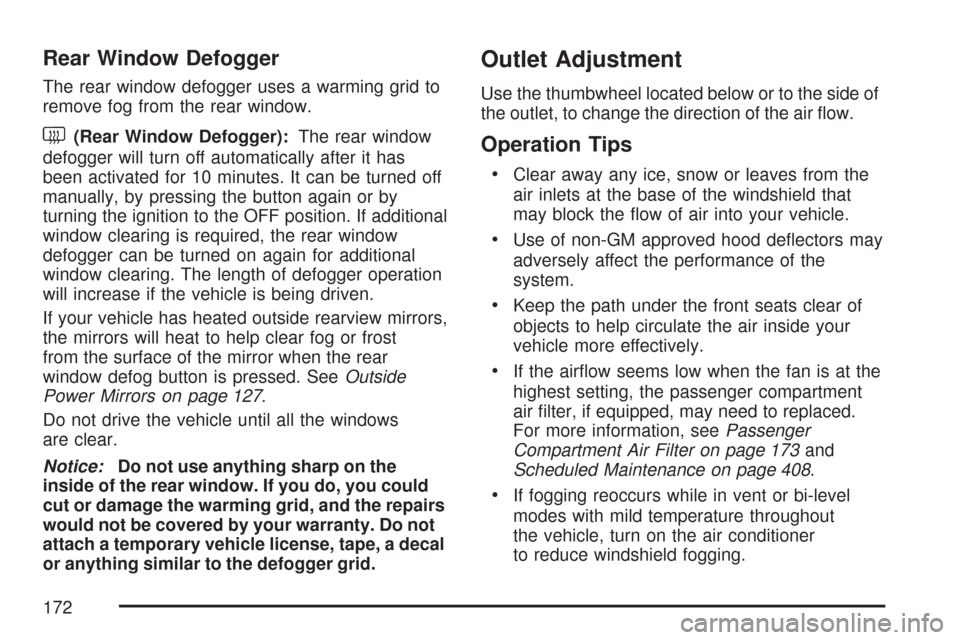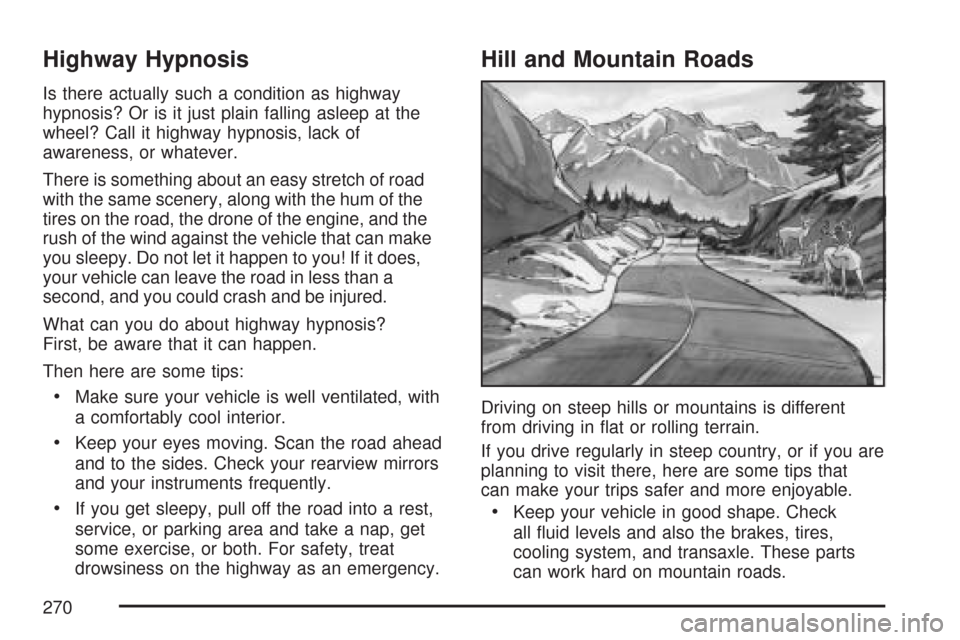2007 CHEVROLET IMPALA rear view mirror
[x] Cancel search: rear view mirrorPage 1 of 460

Seats and Restraint Systems
........................ 7
Front Seats
.............................................. 9
Rear Seats
............................................. 15
Safety Belts
............................................ 18
Child Restraints
...................................... 41
Airbag System
........................................ 68
Restraint System Check
......................... 84
Features and Controls
................................. 87
Keys
....................................................... 89
Doors and Locks
.................................... 98
Windows
............................................... 104
Theft-Deterrent Systems
....................... 107
Starting and Operating Your Vehicle
..... 111
Mirrors
.................................................. 126
OnStar
®System
................................... 128
Universal Home Remote System
.......... 132
Storage Areas
...................................... 144
Sunroof
................................................ 145Instrument Panel
........................................ 147
Instrument Panel Overview
................... 150
Climate Controls
................................... 168
Warning Lights, Gages,
and Indicators
................................... 174
Driver Information Center (DIC)
............ 190
Audio System(s)
................................... 215
Driving Your Vehicle
.................................. 247
Your Driving, the Road, and
Your Vehicle
..................................... 248
Towing
................................................. 282
Service and Appearance Care
................... 293
Service
................................................. 296
Fuel
...................................................... 298
Checking Things Under the Hood
......... 304
Headlamp Aiming
................................. 343
Bulb Replacement
................................ 343
Windshield Wiper Blade Replacement
... 349
2007 Chevrolet Impala Owner ManualM
1
Page 87 of 460

Keys.............................................................. 89
Remote Keyless Entry (RKE) System.......... 90
Remote Keyless Entry (RKE)
System Operation.................................... 91
Doors and Locks.......................................... 98
Door Locks................................................. 98
Power Door Locks....................................... 99
Automatic Door Lock................................. 100
Programmable Automatic Door Unlock....... 100
Rear Door Security Locks......................... 100
Lockout Protection..................................... 101
Trunk........................................................ 102
Windows...................................................... 104
Power Windows........................................ 105
Sun Visors................................................ 107
Theft-Deterrent Systems............................. 107
Content Theft-Deterrent............................. 107
PASS-Key
®III+......................................... 108
PASS-Key®III+ Operation......................... 109Starting and Operating Your Vehicle......... 111
New Vehicle Break-In................................ 111
Ignition Positions....................................... 112
Retained Accessory Power (RAP)............. 113
Starting the Engine.................................... 113
Engine Coolant Heater.............................. 115
Active Fuel Management™
(3.9L V6 and 5.3L V8 Engines).............. 116
Automatic Transaxle Operation.................. 116
Parking Brake........................................... 120
Shifting Into Park (P)................................. 121
Shifting Out of Park (P)............................. 123
Parking Over Things That Burn................. 123
Engine Exhaust......................................... 124
Running the Engine While Parked............. 125
Mirrors......................................................... 126
Manual Rearview Mirror............................. 126
Manual Rearview Mirror with OnStar
®....... 126
Automatic Dimming Rearview Mirror
with OnStar
®.......................................... 126
Outside Power Mirrors............................... 127
Outside Convex Mirror............................... 127
Section 2 Features and Controls
87
Page 126 of 460

Mirrors
Manual Rearview Mirror
If the vehicle has this mirror, it has a lever located at
the bottom of the mirror between the two lamps.
The lever is used to change the mirror from the
day to the night position. To reduce glare from
headlamps behind you while driving at night, pull
the lever toward you. To return the mirror to the day
position, return the lever to its original position.
There are two map lamps located on the bottom of
the mirror. Press the button next to each lamp to
turn it on and off.
Manual Rearview Mirror with
OnStar
®
If the vehicle has this mirror, it has a lever located
at the bottom of the mirror between the two
lamps. The lever is used to change the mirror
from the day to the night position. To reduce glare
from headlamps behind you while driving at
night, pull the lever toward you. To return the
mirror to the day position, return the lever
to its original position.There are two map lamps located on the bottom of
the mirror. Press the button next to each lamp to
turn it on and off.
There are also OnStar
®buttons located at the
bottom of the mirror face. See your dealer for more
information on the system and how to subscribe to
OnStar
®. SeeOnStar®System on page 128for
more information about the services OnStar®
provides.
Automatic Dimming Rearview Mirror
with OnStar
®
The vehicle may have an automatic dimming
rearview mirror with the OnStar®System.
Press the button located below the mirror, on the far
left, for up to three seconds to turn the automatic
dimming feature off and on.
There are two map lamps located on the bottom of
the mirror. Press the button next to each lamp to
turn it on and off.
There are also OnStar
®buttons located at the
bottom of the mirror. See your dealer for more
information on the system and how to subscribe to
OnStar
®. SeeOnStar®System on page 128for
more information about the service OnStar®
provides.
126
Page 144 of 460

Storage Areas
Glove Box
To open the glove box, lift up on the lever.
Cupholder(s)
Your vehicle may have cupholders built into the
front center console, front portion of the front
center seat and rear armrest. To access the front
cupholders, on the �ve-passenger model, pull
out the divider in front of the front center console
to separate the opening into two cupholders. To
access the front cupholders, on the six-passenger
model, fold the front portion of the front center seat
forward.
Sunglasses Storage Compartment
Your vehicle may have a sunglass storage
compartment located above the rearview mirror.
To open, push on cover.
Do not operate the vehicle with the sunglasses
storage compartment cover open, it could obstruct
your view.
Center Console Storage Area
Your vehicle may have a front center console
storage area. To open the front center console
storage area, pull up on the latch located in
the front of the console lid. Inside is a removable
tray and an accessory power outlet.
Rear Storage Area
If your vehicle has the split folding rear seat, there
will be two storage areas underneath. To access
these storage areas, pull the tab(s) located by the
seatbelt buckle on the passenger side and the
center of the rear seat on the driver side. SeeSplit
Folding Rear Seat on page 15for more
information.
Rear Seat Armrest
Your vehicle may have a rear seat armrest.
To access, pull the tab on the armrest forward.
144
Page 163 of 460

When it is dark enough outside, the low-beam
headlamps will turn off and the headlamps
and parking lamps will turn on. The other lamps
that come on with the headlamps will also
come on.
When it is bright enough outside, the headlamps
will go off and the DRL will come on.
As with any vehicle, you should turn on the
regular headlamp system when it is needed.
Fog Lamps
-(Fog Lamps):If your vehicle has fog lamps,
the control is located on the exterior lamps
control. The exterior lamps control is located on
the instrument panel to the left of the steering
column.
The ignition must be in the ON position for the fog
lamps to come on.
To turn the fog lamps on, press the exterior lamps
button. A light will come on in the instrument
panel cluster. Press the exterior lamps button
again to turn the fog lamps off.When the headlamps are changed to high-beam,
the fog lamps also go off.
Some localities have laws that require the
headlamps to be on along with the fog lamps.
Instrument Panel Brightness
D(Instrument Panel Brightness):The knob
with this symbol on it is located next to the exterior
lamps control. Push the knob in all the way until
it pops out and then turn the knob clockwise
to brighten or counterclockwise to dim the lights.
Push the knob back in when �nished.
Courtesy Lamps
When a door is opened, the courtesy lamps
automatically come on. They make it easy for you
to enter and leave your vehicle. You can also
manually turn these lamps on by fully turning the
instrument panel brightness control clockwise.
The reading lamps, located on the rearview
mirror, can be turned on or off independent of the
automatic courtesy lamps, when the doors
are closed.
163
Page 172 of 460

Rear Window Defogger
The rear window defogger uses a warming grid to
remove fog from the rear window.
<(Rear Window Defogger):The rear window
defogger will turn off automatically after it has
been activated for 10 minutes. It can be turned off
manually, by pressing the button again or by
turning the ignition to the OFF position. If additional
window clearing is required, the rear window
defogger can be turned on again for additional
window clearing. The length of defogger operation
will increase if the vehicle is being driven.
If your vehicle has heated outside rearview mirrors,
the mirrors will heat to help clear fog or frost
from the surface of the mirror when the rear
window defog button is pressed. SeeOutside
Power Mirrors on page 127.
Do not drive the vehicle until all the windows
are clear.
Notice:Do not use anything sharp on the
inside of the rear window. If you do, you could
cut or damage the warming grid, and the repairs
would not be covered by your warranty. Do not
attach a temporary vehicle license, tape, a decal
or anything similar to the defogger grid.
Outlet Adjustment
Use the thumbwheel located below or to the side of
the outlet, to change the direction of the air �ow.
Operation Tips
Clear away any ice, snow or leaves from the
air inlets at the base of the windshield that
may block the �ow of air into your vehicle.
Use of non-GM approved hood de�ectors may
adversely affect the performance of the
system.
Keep the path under the front seats clear of
objects to help circulate the air inside your
vehicle more effectively.
If the air�ow seems low when the fan is at the
highest setting, the passenger compartment
air �lter, if equipped, may need to replaced.
For more information, seePassenger
Compartment Air Filter on page 173and
Scheduled Maintenance on page 408.
If fogging reoccurs while in vent or bi-level
modes with mild temperature throughout
the vehicle, turn on the air conditioner
to reduce windshield fogging.
172
Page 263 of 460

If you have the Anti-Lock Brake System (ABS),
remember: It helps avoid only the braking skid.
If you do not have ABS, then in a braking
skid, where the wheels are no longer rolling,
release enough pressure on the brakes to get
the wheels rolling again. This restores steering
control. Push the brake pedal down steadily
when you have to stop suddenly. As long as the
wheels are rolling, you will have steering control.
Driving at Night
Night driving is more dangerous than day driving.
One reason is that some drivers are likely to
be impaired — by alcohol or drugs, with night
vision problems, or by fatigue.
Here are some tips on night driving.
Drive defensively.
Do not drink and drive.
Adjust the inside rearview mirror to reduce the
glare from headlamps behind you.
Since you cannot see as well, slow down and
keep more space between you and other
vehicles.
Slow down, especially on higher speed roads.
Your vehicle’s headlamps can light up only so
much road ahead.
In remote areas, watch for animals.
If you are tired, pull off the road in a safe
place and rest.
No one can see as well at night as in the daytime.
But as we get older these differences increase.
A 50-year-old driver might require at least twice as
much light to see the same thing at night as a
20-year-old.
What you do in the daytime can also affect your
night vision. For example, if you spend the
day in bright sunshine you are wise to wear
sunglasses. Your eyes will have less trouble
adjusting to night. But if you are driving, do not
wear sunglasses at night. They might cut down on
glare from headlamps, but they also make a lot
of things invisible.
263
Page 270 of 460

Highway Hypnosis
Is there actually such a condition as highway
hypnosis? Or is it just plain falling asleep at the
wheel? Call it highway hypnosis, lack of
awareness, or whatever.
There is something about an easy stretch of road
with the same scenery, along with the hum of the
tires on the road, the drone of the engine, and the
rush of the wind against the vehicle that can make
you sleepy. Do not let it happen to you! If it does,
your vehicle can leave the road in less than a
second, and you could crash and be injured.
What can you do about highway hypnosis?
First, be aware that it can happen.
Then here are some tips:
Make sure your vehicle is well ventilated, with
a comfortably cool interior.
Keep your eyes moving. Scan the road ahead
and to the sides. Check your rearview mirrors
and your instruments frequently.
If you get sleepy, pull off the road into a rest,
service, or parking area and take a nap, get
some exercise, or both. For safety, treat
drowsiness on the highway as an emergency.
Hill and Mountain Roads
Driving on steep hills or mountains is different
from driving in �at or rolling terrain.
If you drive regularly in steep country, or if you are
planning to visit there, here are some tips that
can make your trips safer and more enjoyable.
Keep your vehicle in good shape. Check
all �uid levels and also the brakes, tires,
cooling system, and transaxle. These parts
can work hard on mountain roads.
270